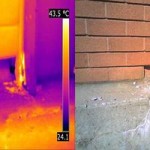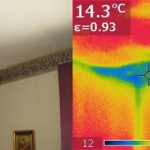Barrie Home Inspector and Thermal Imaging. Combine Infrared Scanning & Home Inspection for your next Barrie Home Inspection. Free Thermal Imaging scans of your Exterior walls and Main electrical panel included with your home inspection package.
 Thermal imaging cameras detect radiation in the infrared range of the electromagnetic spectrum (roughly 9,000-14,000 nanometers or 9-14 m) and produce images of that radiation, called thermograms. Since infrared radiation is emitted by all objects above absolute zero according to the black body radiation law, thermography makes it possible to see one’s environment with or without visible illumination.
Thermal imaging cameras detect radiation in the infrared range of the electromagnetic spectrum (roughly 9,000-14,000 nanometers or 9-14 m) and produce images of that radiation, called thermograms. Since infrared radiation is emitted by all objects above absolute zero according to the black body radiation law, thermography makes it possible to see one’s environment with or without visible illumination.
The discovery of infrared started with a prism being placed into a ray of sunshine in a dark room which then reflected the colours of the rainbow using a property known as dispersion. This is the method Sir William Herschel utilized in the 1800′s in conjunction with thermometers to discern the presence of invisible light rays. He called his discovery the thermometric spectrum later to be known as infrared.
Thermal Imaging can be used for detection of potential equipment failure by measuring abnormal temperature signatures of electrical distribution system components. By evaluating the operating condition of these components, potential failure can be located and problem severity determined as part of a structured ongoing maintenance program.
When using a thermal imaging camera a special lens focuses the infrared light emitted by all of the objects in view. The focused light is scanned by a phased array of infrared-detector elements. The detector elements create a very detailed temperature pattern called a thermogram. It only takes about one-thirtieth of a second for the detector array to obtain the temperature information to make the thermogram. This information is obtained from several thousand points in the field of view of the detector array.
Light is often said to have a colour temperature. What this means is that the colour of the light is the colour of light radiated by a so-called black body which is at that temperature. Colour temperature is measured in Kelvins and the higher the colour temperature the bluer the light. Zero Kelvin is Absolute Zero and the freezing point of water is 273 Kelvins: a Kelvin degree is the same as a Celsius or Centigrade degree. In practice the actual temperature is not the same as the colour temperature.
Thermal Imaging has evolved into one of the most valuable diagnostic tools used for Predictive Maintenance (PM). Also known as Thermography, Thermal Imaging is the production of non-contact infrared, or “heat” pictures from which temperature measurements can be made. By detecting anomalies often invisible to the naked eye, thermography allows corrective action before costly system failures occur. Portable infrared (IR) imaging systems scan electrical systems, then constantly convert the thermal images to visible pictures for quantitive temperature analysis.
The Barrie Home Inspector was the first company in Simcoe County to offer Thermal Imaging as part of a Home Inspection. Our training, experience and knowledge make us the Premier Home Inspection company for residential or commercial property investment.


Recent Comments